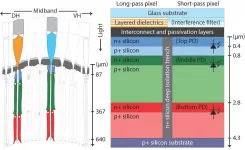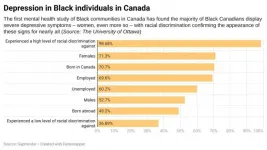(Press-News.org) Who made more accurate predictions about the course of the COVID-19 pandemic - experts or the public? A study from the University of Cambridge has found that experts such as epidemiologists and statisticians made far more accurate predictions than the public, but both groups substantially underestimated the true extent of the pandemic.
Researchers from the Winton Centre for Risk and Evidence Communication surveyed 140 UK experts and 2,086 UK laypersons in April 2020 and asked them to make four quantitative predictions about the impact of COVID-19 by the end of 2020. Participants were also asked to indicate confidence in their predictions by providing upper and lower bounds of where they were 75% sure that the true answer would fall - for example, a participant would say they were 75% sure that the total number of infections would be between 300,000 and 800,000.
The results, published in the journal PLOS ONE, demonstrate the difficulty in predicting the course of the pandemic, especially in its early days. While only 44% of predictions from the expert group fell within their own 75% confidence ranges, the non-expert group fared far worse, with only 12% of predictions falling within their ranges. Even when the non-expert group was restricted to those with high numeracy scores, only 16% of predictions fell within the ranges of values that they were 75% sure would contain the true outcomes.
"Experts perhaps didn't predict as accurately as we hoped they might, but the fact that they were far more accurate than the non-expert group reminds us that they have expertise that's worth listening to," said Dr Gabriel Recchia from the Winton Centre for Risk and Evidence Communication, the paper's lead author. "Predicting the course of a brand-new disease like COVID-19 just a few months after it had first been identified is incredibly difficult, but the important thing is for experts to be able to acknowledge uncertainty and adapt their predictions as more data become available."
Throughout the COVID-19 pandemic, social and traditional media have disseminated predictions from experts and nonexperts about its expected magnitude.
Expert opinion is undoubtedly important in informing and advising those making individual and policy-level decisions. However, as the quality of expert intuition can vary drastically depending on the field of expertise and the type of judgment required, it is important to conduct domain-specific research to establish how good expert predictions really are, particularly in cases where they have the potential to shape public opinion or government policy.
"People mean different things by 'expert': these are not necessarily people working on COVID-19 or developing the models to inform the response," said Recchia. "Many of the people approached to provide comment or make predictions have relevant expertise, but not necessarily the most relevant." Recchia noted that in the early COVID-19 pandemic, clinicians, epidemiologists, statisticians, and other individuals seen as experts by the media and the general public, were frequently asked to give off-the-cuff answers to questions about how bad the pandemic might get. "We wanted to test how accurate some of these predictions from people with this kind of expertise were, and importantly, see how they compared to the public."
For the survey, participants were asked to predict how many people living in their country would have died and would have been infected by the end of 2020; they were also asked to predict infection fatality rates both for their country and worldwide.
Both the expert group and the non-expert group underestimated the total number of deaths and infections in the UK. The official UK death toll at 31 December was 75,346. The median prediction of the expert group was 30,000, while the median prediction for the non-expert group was 25,000.
For infection fatality rates, the median expert prediction was that 10 out of every 1,000 people with the virus worldwide would die from it, and 9.5 out of 1,000 people with the virus in the UK would die from it. The median non-expert response to the same questions was 50 out of 1,000 and 40 out of 1,000. The real infection fatality rate at the end of 2020--as best the researchers could determine, given the fact that the true number of infections remains difficult to estimate--was closer to 4.55 out of 1,000 worldwide and 11.8 out of 1,000 in the UK.
"There's a temptation to look at any results that says experts are less accurate than we might hope and say we shouldn't listen to them, but the fact that non-experts did so much worse shows that it remains important to listen to experts, as long as we keep in mind that what happens in the real world can surprise you," said Recchia.
The researchers caution that it is important to differentiate between research evaluating the forecasts of 'experts'--individuals holding occupations or roles in subject-relevant fields, such as epidemiologists and statisticians--and research evaluating specific epidemiological models, although expert forecasts may well be informed by epidemiological models. Many COVID-19 models have been found to be reasonably accurate over the short term, but get less accurate as they try to predict outcomes further into the future.
INFORMATION:
When access to free and low-cost birth control goes up, the percentage of young women who leave high school before graduating goes down by double-digits, according to a new CU Boulder-led study published May 5 in the journal Science Advances.
The study, which followed more than 170,000 women for up to seven years, provides some of the strongest evidence yet that access to contraception yields long-term socioeconomic benefits for women. It comes at a time when public funding for birth control is undergoing heated debate, and some states are considering banning certain forms.
"One of the foundational ...
One of the dangerous health conditions that can occur among premature newborns, children born with heart defects, and some others is pulmonary arterial hypertension (PAH).
Commonly mistaken for asthma, this condition occurs when blood vessels in the lungs develop excessive resistance to blood flow. This forces the heart's right ventricle to work harder, causing it to enlarge, thicken and further elevate blood pressure. While early treatment usually succeeds, the condition can become persistent and progressive, which can lead to heart failure and death.
The exact incidence and prevalence of PAH remains unclear, but reviews of patient registries in Europe have estimated that the condition occurs in nearly 64 of every 1 million children, including transient cases. ...
Inspired by the powerful eyes of the mantis shrimp, scientists have designed an imaging system that can distinguish between cancerous and healthy tissues during cancer surgery. The system accurately labeled tumors in mice and visualized lymph nodes near tumors in 18 patients undergoing surgery for breast cancer. With further development, the camera could help surgeons remove the marginal tumor tissues that can remain after unguided surgery, potentially lowering the risk of cancer relapse. It is critical for surgeons to remove as much tumor tissue as possible during surgery, but anywhere from 25% ...
Machine learning algorithms can leverage vast amounts of consumer data, allowing automation of business decisions such as pricing, product offerings, and promotions. Airbnb, an online marketplace for vacation rentals and other lodging, created an algorithm-based smart-pricing tool that is free to all Airbnb hosts and allows hosts to set their properties' daily price automatically. A new study investigated the impact of Airbnb's algorithm on racial disparities among Airbnb hosts. Adopting the tool narrowed the revenue gap between White and Black ...
An Austrian-American research team (University of Vienna, Department Evolutionary Anthropology and Harvard Medical School, Department of Genetics), in collaboration of Hungarian experts from Eötvös Loránd University, has developed a new method that allows the almost non-destructive extraction of genetic material from archaeological human remains. The method allows anthropologists, archaeologists and archaeogeneticists to avoid the risk of serious damage to artefacts of significant scientific and heritage value, which can then be fully examined in future research.
Bioarcheological ...
The first mental health study of Black communities in Canada has found the majority of Black Canadians display severe depressive symptoms - women, even more so - with racial discrimination confirming the appearance of these signs for nearly all.
The study, published in Depression and Anxiety, discovered nearly two-thirds (65.87 percent) of surveyed participants reported severe depressive symptoms. Higher rates were found among women; those who are employed; those born in Canada; and nearly all who have been experienced high racial discrimination.
"Rates of depressive symptoms among Black individuals are nearly six times the 12-month prevalence reported for the general population in Canada," says ...
Granular materials, such as sand and gravel, are an interesting class of materials. They can display solid, liquid, and gas-like properties, depending on the scenario. But things can get complicated in cases of high-speed vehicle locomotion, which cause these materials to enter a "triple-phase" nature, acting like all three fundamental phases of matter at the same time.
As reported in the April 23, 2021 issue of the journal Science Advances, a team of engineers and physicists from the Massachusetts Institute of Technology (MIT) and Georgia Institute ...
The field of photonics aims to transform all manner of electronic devices by storing and transmitting information in the form of light, rather than electricity. Beyond light's raw speed, the way that information can be layered in its various physical properties makes devices like photonic computers and communication systems tantalizing prospects.
Before such devices can go from theory to reality, however, engineers must find ways of making their light sources -- lasers -- smaller, stronger and more stable. Robots and autonomous vehicles that use LiDAR for optical sensing and ranging, manufacturing and material ...
Scientists are certain that dark matter exists. Yet, after more than 50 years of searching, they still have no direct evidence for the mysterious substance.
University of Delaware's Swati Singh is among a small group of researchers across the dark matter community that have begun to wonder if they are looking for the right type of dark matter.
"What if dark matter is much lighter than what traditional particle physics experiments are looking for?" said Singh, an assistant professor of electrical and computer engineering at UD.
Now, Singh, Jack Manley, a UD doctoral student, and collaborators at ...
BUFFALO, N.Y. -- You might call Candida albicans a shape-shifter: As this fungus grows, it can multiply as single, oval-shaped cells called yeast or propagate in an elongated form called hypha, consisting of thread-like filaments.
This dual nature can help the pathogen survive in the body, where it can cause disease, including dangerous hospital-acquired infections.
But how does this switching ability occur?
New research identifies one factor that may contribute. In a study that will be published on May 5 in the journal mSphere, University at Buffalo biologists Guolei Zhao and Laura Rusche report that a protein called Sir2 may facilitate C. albicans' transition from ovoid yeast ...






